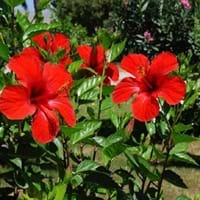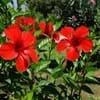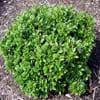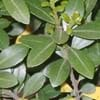Life Span
Annual and Perennial
Perennial
Type
Broadleaf Evergreen
Shrub
Origin
China
North America, United States, Northeastern United States, Mid-Atlantic United States, Southeastern United States, Canada
Types
Not Available
Red chokeberry, Purple chokeberry
Number of Varieties
Not Available
Habitat
gardens, Grassland, Homesteads, Subtropical climates, tropical environments
Anthropogenic, Boggy areas, Cliffs, Fens, Swamps, Terrestrial, Wet lands, Woodlands
USDA Hardiness Zone
9-15
3-8
AHS Heat Zone
Not Available
8-1
Sunset Zone
21,22
A2, A3, 1a, 1b, 2a, 2b, 3a, 3b, 4, 5, 6, 7
Habit
Oval or Rounded
Thicket/Colonizing
Flower Color
Yellow, Red, Dark Red
Not Available
Flower Color Modifier
Bicolor
Not Available
Fruit Color
Not Available
Purplish-black
Leaf Color in Spring
Dark Green
Not Available
Leaf Color in Summer
Dark Green
Not Available
Leaf Color in Fall
Dark Green
Not Available
Leaf Color in Winter
Dark Green
Not Available
Leaf Shape
Ovate
Elliptic
Plant Season
Spring, Summer, Fall, Winter
Spring, Summer, Fall
Sunlight
Full Sun, Partial Sun
Full Sun, Partial Sun, Partial shade
Growth Rate
Medium
Medium
Type of Soil
Loam
Clay, Loam
The pH of Soil
Neutral
Acidic, Neutral, Alkaline
Soil Drainage
Well drained
Average
Bloom Time
Early Summer, Summer, Late Summer, Early Fall, Fall, Indeterminate
Late Spring, Early Summer
Tolerances
Drought, Variety of soil types
Not Available
Where to Plant?
Ground, Pot
Ground, Pot
How to Plant?
Stem Cutting, Tip cutting, Vegetative Reproduction
Cuttings, Divison, Seedlings
Plant Maintenance
Medium
Medium
Watering Requirements
It cannot sustain wet-feet, Keep the Soil well drained, Requires watering in the growing season, Water Deeply, Water frequently while growing, Water more in summer, Water when soil is dry
Average Water Needs, Do Not over Water, Requires regular watering
In Summer
Lots of watering
Lots of watering
In Spring
Moderate
Moderate
In Winter
Average Water
Average Water
Soil pH
Neutral
Acidic, Neutral, Alkaline
Soil Type
Loam
Clay, Loam
Soil Drainage Capacity
Well drained
Average
Sun Exposure
Full Sun, Partial Sun
Full Sun, Partial Sun, Partial shade
Pruning
A hard prune may be necessary if the plant becomes woody, Cut leaves after fall, Cut or pinch the stems, Pinch or prune as they grow to promote branching and bushiness, Prune for shortening long shoots, Prune in early summer, Remove deadheads
Prune after flowering, Remove branches that rub together, Remove damaged leaves, Remove dead branches, Remove dead leaves, Remove diseased branches by the tool's blades dipped into the alcohol solution
Fertilizers
Apply 10-10-10 amount, Balanced liquid fertilizer, Do not fertilize new plants until at least a month, Use a low phosphate fertilizer to improve the quality of the blooms
10-10-10, All-Purpose Liquid Fertilizer, Apply N-P-K
Pests and Diseases
Aphids, Mealybugs, Red spider mite, Scale, Thripes, Whiteflies
Red blotch
Plant Tolerance
Drought, Variety of soil types
Not Available
Flower Petal Number
Single
Not Available
Foliage Texture
Medium
Not Available
Foliage Sheen
Glossy
Not Available
Attracts
Bees, Butterflies, Hummingbirds
Not Available
Allergy
no allergic reactions
Anaphylaxis
Aesthetic Uses
Beautification, Borders, Landscape Designing
Showy Purposes
Beauty Benefits
Hair Conditioner, Not Available, Prevents greying of hair, Prevents Premature Baldness, Promotes Healthy Hair, Promotes healthy skin, Speed hair growth
Good for skin
Environmental Uses
Air purification
Air purification, Food for birds, Wildlife
Medicinal Uses
anti-inflammatory, Diuretic, Hair Loss, High blood pressure, Vitamin C
anti-cancer, Antioxidants, Cold
Part of Plant Used
Flowers, Leaf Stalks, Leaves
Fruits
Other Uses
Culinary use, Employed in herbal medicine, Jam, Jelly, Making Shampoo, Oil is used for aromatherapy, Oil is used in perfume, soaps, creams, etc., Showy Purposes, Traditional medicine, Use in Chinese herbology, Used As Food, Used as Ornamental plant, Used for bedding in gardens, Used for fragrance, Used for its medicinal properties, Used in making beverages, Used in paper industry, Used in salads, Used to make hair tonic
Pectin
Used As Indoor Plant
No
No
Used As Outdoor Plant
Yes
Yes
Garden Design
Container, Foundation, Houseplant, Mixed Border, Tropical
Foundation, Mixed Border
Botanical Name
HIBISCUS rosa-sinensis 'Lillikoi Yellow'
ARONIA melanocarpa
Common Name
China rose
Black Chokeberry
In Hindi
गुड़हल, जवा कुसुम
Black Chokeberry Shrub
In German
Tropical Hibiscus
Schwarz Aronia Strauch
In French
Hibiscus Tropical
Noir Chokeberry Arbuste
In Spanish
hibisco tropical
Chokeberry negro Arbusto
In Greek
τροπική Hibiscus
Μαύρο Chokeberry θάμνων
In Portuguese
Hibiscus tropical
Chokeberry preto Arbusto
In Polish
Tropical Hibiscus
Krzew aronii
In Latin
Tropical Hibiscus
Lichen Frutex
Phylum
Magnoliophyta
Magnoliophyta
Class
Magnoliopsida
Magnoliopsida
Family
Malvaceae
Rosaceae
Clade
Angiosperms, Eudicots, Rosids
Angiosperms, Eudicots, Rosids
Subfamily
Malvoideae
Amygdaloideae
Number of Species
Not Available
Season and Care of Chinese hibiscus and Black Chokeberry
Season and care of Chinese hibiscus and Black Chokeberry is important to know. While considering everything about Chinese hibiscus and Black Chokeberry Care, growing season is an essential factor. Chinese hibiscus season is Spring, Summer, Fall and Winter and Black Chokeberry season is Spring, Summer, Fall and Winter. The type of soil for Chinese hibiscus is Loam and for Black Chokeberry is Clay, Loam while the PH of soil for Chinese hibiscus is Neutral and for Black Chokeberry is Acidic, Neutral, Alkaline.
Chinese hibiscus and Black Chokeberry Physical Information
Chinese hibiscus and Black Chokeberry physical information is very important for comparison. Chinese hibiscus height is 600.00 cm and width 60.00 cm whereas Black Chokeberry height is 182.88 cm and width 182.88 cm. The color specification of Chinese hibiscus and Black Chokeberry are as follows:
Chinese hibiscus flower color: Yellow, Red and Dark Red
Chinese hibiscus leaf color: Dark Green
Black Chokeberry flower color: Not Available
- Black Chokeberry leaf color: Not Available
Care of Chinese hibiscus and Black Chokeberry
Care of Chinese hibiscus and Black Chokeberry include pruning, fertilizers, watering etc. Chinese hibiscus pruning is done A hard prune may be necessary if the plant becomes woody, Cut leaves after fall, Cut or pinch the stems, Pinch or prune as they grow to promote branching and bushiness, Prune for shortening long shoots, Prune in early summer and Remove deadheads and Black Chokeberry pruning is done Prune after flowering, Remove branches that rub together, Remove damaged leaves, Remove dead branches, Remove dead leaves and Remove diseased branches by the tool's blades dipped into the alcohol solution. In summer Chinese hibiscus needs Lots of watering and in winter, it needs Average Water. Whereas, in summer Black Chokeberry needs Lots of watering and in winter, it needs Average Water.





